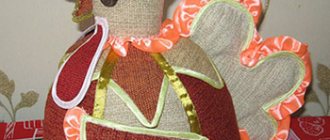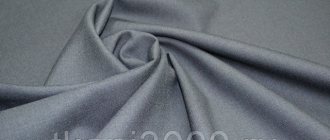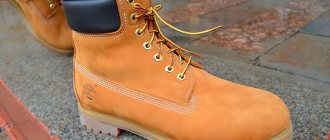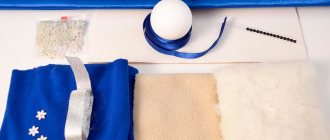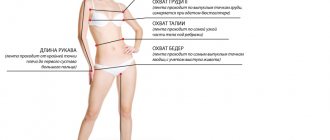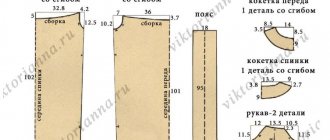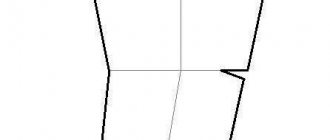Wool is considered a true animal fiber when it is sheared from live sheep. “Dead” wool, collected from slaughterhouses, is in all respects much worse than “live” wool.
About 270 thousand tons of sheep wool are produced annually in the world, with about a third of this amount coming from Australia, and the rest from the CIS countries, New Zealand, Argentina, South Africa, Uruguay, China, Turkey and the USA.
Woolen fabrics, made from a mixture of long and short fibers, are soft (although they do not wrinkle) but do not retain a sharp fold. Worsted wool fabrics, or combed wool fabrics, are made from long fibers only. They are smooth, strong, quite durable, but acquire a gloss as they are worn. For the first time, recycled wool tends to produce textiles that are stronger and more resilient than other types of wool.
Wool is the hair of animals (sheep, goats, camels, etc.). The bulk of wool processed in industry is sheep. Types of wool fibers: fluff (the most valuable thin, soft crimped fiber), transition hair, awn (thicker, stiffer and less crimped fiber than fluff) and “dead hair” (low strength and hard). Wool is used to produce yarn, fabrics, knitwear, felting products, etc.
Types of domestic cat hair.
Cat hair, like that of all mammals, consists of hard, keratinized elastic thread-like structures formed by epithelial cells. Hair grows from the surface layer of the skin called the epidermis. The type of hair is determined by its structure. The muscles located directly under the skin (the levator muscles) are extremely sensitive to changes in ambient temperature. In cold weather, or when the cat is frightened or anxious, the muscles tighten in such a way that the hair stands up, fluffing up and giving the cat a characteristic "frightening" appearance. They also work when communicating with other animals. Cat hair can combine up to three types of hair (regular, “double” and “triple” hair). In addition, cats always have whiskers - this is also hair. A cat's hair density is approximately five times that of a human and three times that of a dog, typically ranging from 800 to 1,600 hairs per square centimeter.
Vibrissae.
The long, thickened tactile hairs growing on each side of the upper lip (whiskers), above the eyes, on the cheeks, and on the outside of the lower leg of cats are called whiskers. They do not serve for decoration at all. Because their hair follicles are richer in nerve endings than regular hair, the whiskers are extremely sensitive and play an important role in cats' ability to navigate in the dark, determine the size of holes in their path, and even help in identifying odors. With the help of whiskers, the cat determines the strength and direction of the wind, which helps it calculate the jump. Air vibrations reflected from objects are caught by vibrissae, which allows the cat to navigate even in complete darkness (contrary to popular belief, a cat cannot see in the dark). Holding the caught prey in its teeth, the cat controls it without using its vision. Whiskers are also an important sign language tool for cats.
Protective (Preservative) hair
Long, coarse hair that makes up the bulk of a cat's hair. These hairs usually determine the cat's base coat color. Protective hair also inhibits the rapid penetration of water into the cat's skin. This type of hair makes up the top layer of a cat's coat. Their purpose is to protect the undercoat and guard hairs. The shape of the hair is conical, with a uniform decrease in diameter towards the tip of the hair.
Undercoat
Sometimes such hair is called undercoat. Consists of soft, fluffy hairs. Located directly next to the cat's skin. The diameter of such hairs does not change along the entire length. Serves to maintain a constant temperature in the cat's skin, protects not only from cold, but also from overheating. If the cat is not brushed regularly, the undercoat can form a dense, “felt” layer. Hair of this type is the most numerous, their number is three times greater than the number of guard hairs and tens of times the number of protective hairs. For purebred cats, these proportions are different, since they have been subjected to targeted selection for generations.
Guard hairs
Typically, guard hairs are those that form the basis of a cat's coat, but are thinner than guard hairs. Guard hairs make up the middle layer of a cat's coat. The hair is quite hard, bristly, and has some thickening at the tip. Depending on the breed of cat, the structure of the guard hairs may vary. In some breeds (British Shorthair, for example), the guard hairs can be the same length as the guard hairs. In other breeds, such as the Manx, they are much shorter than guards.
Pooh
Very thin sparse (“baby”) hairs. These can be seen on cats of Sphynx breeds. Other breeds also have them, but they are not so easy to detect.
Cooling system
According to anthropologists, at the time when a person lost his hair, he lived in a fairly warm climate. However, despite the heat, at first the fur did not bother him at all, since he moved little, eating only plants and small animals. Then wool protected our ancestor from sunlight and mechanical damage.
With the invention of tools, man was able to hunt larger game. And then he had to start moving faster. It is clear that running in a fur coat is not very comfortable: you will overheat. Therefore, wool gradually sank into oblivion.
In addition, during the process of hair loss, the number of sweat glands in the human body increased. And sweat, of course, evaporates better from bare skin than from fur. The remaining hair ceased to have such a bouquet of benefits as wool due to its uselessness.
Features of the structure of wool (hair) and other skin formations
Features of the structure of the skin and their derivatives, taking into account the various living conditions of chordates. Read more: Skin glands in chordates. Functions, structural features
2.3 Features of the structure of wool (hair) and other skin formations
The skin of mammals is characterized by thickness, the presence of papillae at the border between the epidermis and corium, the presence of loose subcutaneous tissue, an abundance of skin glands and a wealth of various kinds of horny formations, of which the most important are hair and its modifications. Hair is one of the most characteristic horny structures of mammals. They are found only in representatives of this class and are characteristic of almost all animals. Only a very few cetacean mammals (beluga whale, narwhal) have no hair at all; all other animals, including most cetaceans, have at least a small amount of hair (fetal whales have some hair on their lips). The development of hair in the first stages proceeds similar to the first stages of development of scales and feathers, i.e. an accumulation of epidermal cells is formed. Then the cells descend deep into the skin itself and further hair development proceeds in a unique way.
Hair (Fig. 7) consists of two main parts: a shaft protruding above the skin and a root immersed in the skin. In turn, the hair shaft consists of a loose core substance, a dense cortical layer surrounding it and a thin outer skin. The medulla fills the so-called central channel of the hair and consists of loose porous tissue, between the cells of which air is located. All wild mammals have a core, but the degree of development varies greatly among different animals. The core is extremely fragile, but due to the abundance of air it has a significant effect on the thermal conductivity of the fur. Due to this property, the core reaches its greatest thickness in animals living in cold climates, in particular in reindeer, as a result of which the fur of this animal is brittle, but at the same time very warm. The dense cortical layer gives the hair strength, stretchability and elasticity. The degree of development of this layer also varies greatly. Finally, the role of the skin is to protect the underlying layers of hair from various physical and chemical influences.
Rice. 7. Longitudinal section of a hair in the skin (according to Parker): / - the stratum corneum of the Epidermis, 2 - its Malpighian layer, 3 - the skin itself, 4 - the sebaceous gland, 5 - the core of the hair, c - the cortex of the hair, 7 - the vitreous membrane between hair sheath and hair follicle, 8 - hair follicle, 9 - hair sheath, 10 - hair papilla with vessels, // - adipose tissue, 12 - hair follicle muscle
From below, the hair shaft gradually turns into the root, which ends in a pear-shaped extension - the hair follicle. The latter, at least in its lower part, consists of homogeneous, completely vital cells. At the base of the growing hair follicle there is a hair papilla, rich in blood vessels, which serves to nourish the hair. The hair root is more or less deeply immersed in the skin itself and sits in the hair follicle. Its walls are formed by two layers: the outer one - the hair follicle, and the inner one, adjacent to the hair - the hair sheath. It is a continuation of the epidermis, which protrudes into the hair follicle and, reaching the base of the hair follicle, turns upward, adjacent directly to the hair root. The duct of the sebaceous gland usually opens into the hair sac, the fatty secretion of which lubricates the hair, protecting it from wetting with water. Below the sebaceous gland, a bundle of smooth muscle fibers is attached to the hair follicle, the other end of which is lost in the superficial layers of the skin itself. As these muscles contract, the hair sac slightly changes its position, and the hair straightens - the animal “bristles.” In the vast majority of animals, the hair is located in the skin not perpendicular to its surface, but somewhat obliquely. Thanks to this, the hair shafts are more or less adjacent to the surface of the skin and face the tops or a certain side. This phenomenon is known as lint. Only a few burrowing animals, for example, the mole, the blind man, which move in their underground passages both head first and vice versa, do not have pile, so no matter in which direction you smooth their skin, the hair always lies equally evenly.
Modifications of hair are vibrissae, bristles and needles; the latter play the role of a protective device and are especially developed in hedgehogs, porcupines and echidnas. The vibrissae, which, as already mentioned, play the role of additional organs of touch, in many animals are located, in addition to the head, on the paws and chest, and in the mole - at the end of the tail - in a word, in general in places that in this or that animal are especially often in contact with a dense outdoor environment.
Fur. Only a few animals - elephants, sirens, rhinoceroses - have hair so sparse that there is no need to talk about fur. The density and length of fur can be very different and are associated not only with the systematic position of the animal, but also with its geographical distribution and time of year: as a general rule: animals living in cold climates. The hairs that make up the fur are not uniform. There are longer sparse hairs that produce pile - wool, or awn, and densely located thin hairs - undercoat. The two-tiered fur is especially pronounced, i.e., the division of the hair into the axis and the undercoat, in some aquatic and semi-aquatic mammals: beaver, muskrat, platypus, otter, fur seal, as well as in northern fur-bearing animals. In some animals, the fur consists mainly of undercoat; such are the mole, the mole rat, in others - mainly or even exclusively from the awns, for example, adult seals, the summer fur of deer and wild boars. Shedding - the process of losing old hair and replacing it with new ones can occur very gradually, stretching over a long period of time, and, or vice versa, violently, in a short period of time. As a rule, rapid molting occurs in animals living in temperate and cold zones. Most animals have two molts during the year - spring (fast) and autumn (slow).
The skin itself (corium) of mammals consists mainly of fibrous connective tissue, the individual fibers of which form a complex weave. It is always richly supplied with blood vessels, and the deep layers, consisting of loose connective tissue and called subcutaneous tissue, usually contain significant fat accumulations. The fat accumulations of aquatic mammals—whales, seals, in which they form a thick layer that greatly reduces heat transfer—and in animals that hibernate: for example, marmots, ground squirrels, bats, badgers, and bears, reach particular development. In hibernating animals, fat serves mainly as a reserve nutrient material, and its quantity varies greatly with the seasons: in the fall, before the animal goes into hibernation, it reaches its greatest thickness; in the spring, before awakening, it is almost completely used up.
The epidermis of mammals has different thicknesses not only among equal groups, but also on different parts of the body of the same animal. It reaches its greatest thickness in those parts of the body that are especially susceptible to friction, for example, on the soles of the feet, the buttocks of most monkeys (ischial calluses), and on the knees of camels. From the surface of the stratum corneum, individual dead cells or groups of cells in the form of “dandruff” are constantly falling off, but from the inside it is constantly growing due to the division of cells of the lower, main layer of the epidermis, known as the malpighian layer. The horny formations of terrestrial mammals include nails, various claws and hooves (Fig. 8). These formations are completely absent only in cetaceans and on most fingers of the forelimbs of bats, and are more or less underdeveloped in sirenians and many seals. In all other mammals they are well developed and are of great ecological importance. This is proven by the fact that not only the method of movement of the animal, but also the work of its limbs are associated with the presence of one or another of these formations. The nails, which are characteristic of monkeys, and partly of prosimians, have a more or less flat shape and cover the end of the finger only from above. In addition, the nail has a well-developed soft finger pad covering the bottom of the end of the finger, which is only weakly expressed in the claw. Claws, which are most widespread among mammals, differ from nails in their greater thickness and curvature of the upper horny nail plate, which covers the end of the finger from the sides and protrudes with a point beyond its anterior edge. The claw also has a well-defined lower wall—a looser plantar plate that is underdeveloped in the nail. Finally, the hoof, covering the terminal phalanx not only in front and from the sides, but also from below and forming something like a thick horny shoe, represents a further complication of the claw. In the hoof, there is a horny wall, which corresponds to the nail plate, a horny sole and a frog. The latter corresponds to the pad of the claw (or nail), which in this case is keratinized and projects from below at an acute angle into the horny sole. Hooves are characteristic of large running or rock-climbing mammals.
Rice. 8. Longitudinal section through the ends of the fingers of mammals (according to Boas). / - monkey, II - human, III - predator, IV - horse, 1 - claw or nail plate, 2 - horny wall of the hoof, 3 - pad, 4 - frog, 5 - plantar plate
Features of the structure of the skin and their derivatives, taking into account the various living conditions of chordates. Read more: Skin glands in chordates. Functions, structural features
Information about the work “Comparative review of the skin of chordates”
Section: Biology Number of characters with spaces: 41333 Number of tables: 0 Number of images: 7
Similar works
phylum chordata. General characteristics and life activity
122106
0
17
..., which, in addition to coniferous seeds, eat a lot of seeds of cereals and legumes, mice, which, unlike voles, eat relatively little grass. Seed eaters are relatively limited in their ability to obtain food, and the success of their life activity often depends on the yield of seeds of a few plant species. Crop failures of such food lead to mass migrations of animals or their death. So, for example, our squirrel in the years of poor coniferous harvest...
Concepts of modern natural science
451842
0
2
... about biological causation. A number of phenomena that vitalism considered specific to biological objects (the ability for self-regulation, complication of structure, achieving one result in different ways) are considered in modern natural science as typical manifestations of the processes of self-organization of any sufficiently complex systems, not just living ones. N. Bohr: “not a single result of biological...
Biology of the muskrat in the Zeya district of the Amur region
148979
6
17
... under the snow, making passages and nests there, but they quickly froze and died. Since 2003, more favorable weather conditions for muskrats began and, in connection with this, the number began to increase. Figure 7 - Graph of the number of muskrats in the Zeya region for 2004-2008. 2.12 Method of catching muskrats Hunters go out to hunt muskrats after September 15th. By this time, the muskrat has finished molting. ...
Morphological characteristics of the raccoon dog in the Belogorsk region
98424
6
0
... from birth to the first autumn of his life reaches 50%. In 2007, 21 raccoon dogs were killed by hunters in the Belogorsk region. 2.3 Morphological characteristics of male and female raccoon dogs in the Belogorsk region To conduct morphological studies, three females and three males of raccoon dogs living in the Belogorsk region were obtained. The average weight of male raccoon dogs...
How is wool different from hair?
Hair plays an important role in human life: it protects us from heat and cold. However, animal fur is capable of more. For example, the core of the hair follicle of wool is designed in such a way that it is able to repel water and thereby prevent moisture from entering the skin. While human hair still allows moisture to pass through.
In addition, human hair grows almost constantly. But wool growth is strictly regulated and depends on the season. The fur only grows to a certain length, after which it changes - shedding.
In addition, unlike humans, animals also have a layer of fluff under the main layer of fur, which is located near the surface of the skin. Down protects the skin and fur itself from damage and is involved in heat regulation.
The structure of animal fur
Animal fur can be different. Villi can vary in length, color and hardness. For example, a large dog's fur will be longer than a cat's.
In addition, the fur of animals differs in thickness. The shortest and thickest part is the undercoat, which is located close to the animal’s skin. Above it grow longer villi, called guard hairs.
Name these animals. Find out animals unknown to you with the help of an identification atlas. Test yourself on p. 91.
The picture shows: a bat, a chipmunk, a wild boar, an elk, a mole, a beaver and an otter.
You can check yourself using the photo:
If you don’t know any of these animals, then open the identification atlas and look at the pictures to see what they are called. You can also find in the book information about the features of the appearance and lifestyle of these animals.
Consider the bat, mole, beaver, and otter in the picture. What is unusual about the structure of the body? Think and explain what this is connected with.
Unusual features can be found in the body structure of the bat, mole, beaver and otter.
A bat has wings that allow it to move through the air.
The mole has very poor eyesight, so it hides from the light in dark holes deep in the ground.
The beaver has a long, flat tail that looks like a shovel. It helps the beaver move through the water.
The otter has an elongated, elongated body, which allows it to swim faster and keep up with its prey.
Beasts are animals whose bodies are covered with hair.
Name the main characteristics of animals.
Signs of animals: fur on the body and feeding the cubs with milk.
Why is the second name for animals mammals?
The name of the animals is mammal because the animals feed their young with milk.
Give examples of animals.
Examples of animals: elephant, elk, deer, bear, fox, lion, wolf, wild boar, otter, ferret, squirrel, chipmunk.
Source
About the undercoat
Fluffy and shorter hairs in cats are called undercoat. they grow closest to the skin. Each hair is thicker in diameter at the base and tapers towards the end. To prevent the pet from getting hypothermic in winter and overheating in summer, nature has provided such fluff for it.
You, as the owner, should regularly brush your pet during intense shedding in spring and autumn. Otherwise, the undercoat will become matted and tangles will form. They can be found in both short-haired and long-haired individuals. Most often on the collar, on the body under the paws, the tail.
Wool fabric production
The wool production process is divided into several stages. First, the sheep are treated with an antiseptic, after which the wool is sheared. It is usually carried out in spring or summer, one to three times a year. This process can be painful for the animals if the person cutting the hair does not take care of their skin, leaving wounds. Shearing is done either manually or using a controlled robot (to increase production rates). The removed wool is cleaned of sand, dirt, grease and sweat by placing it in baths with water, soap and soda.
After this, the painstaking work of sorting begins, which takes place in two stages: primary sorting involves separating good wool from bad ones, and secondary sorting involves sorting fibers by quality. Thus, the wool from the shoulder blades and sides of animals, soft and durable, is used to produce clothing items, and the wool from the lower parts of the legs is used for coarse home textiles.
Next comes combing, that is, straightening the fibers, for which they are driven through a series of metal teeth - a kind of comb. At the same stage, residual dirt is removed. After combing, the future worsted fabric is subjected to additional combing to remove short fibers and parallel placement of long ones. After obtaining clean, high-quality and combed fibers, they are twisted into threads - yarn, in order to then weave woolen fabric. At the last stage, the fabric is subjected to various treatments: dyeing, heat shrinking, immersion in water for stronger adhesion of the fibers.
